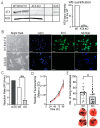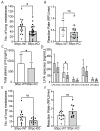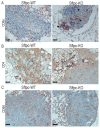Prometastatic Effect of ATX Derived from Alveolar Type II Pneumocytes and B16-F10 Melanoma Cells
- PMID: 35326737
- PMCID: PMC8946623
- DOI: 10.3390/cancers14061586
Prometastatic Effect of ATX Derived from Alveolar Type II Pneumocytes and B16-F10 Melanoma Cells
Abstract
Although metastases are the principal cause of cancer-related deaths, the molecular aspects of the role of stromal cells in the establishment of the metastatic niche remain poorly understood. One of the most prevalent sites for cancer metastasis is the lungs. According to recent research, lung stromal cells such as bronchial epithelial cells and resident macrophages secrete autotaxin (ATX), an enzyme with lysophospholipase D activity that promotes cancer progression. In fact, several studies have shown that many cell types in the lung stroma could provide a rich source of ATX in diseases. In the present study, we sought to determine whether ATX derived from alveolar type II epithelial (ATII) pneumocytes could modulate the progression of lung metastasis, which has not been evaluated previously. To accomplish this, we used the B16-F10 syngeneic melanoma model, which readily metastasizes to the lungs when injected intravenously. Because B16-F10 cells express high levels of ATX, we used the CRISPR-Cas9 technology to knock out the ATX gene in B16-F10 cells, eliminating the contribution of tumor-derived ATX in lung metastasis. Next, we used the inducible Cre/loxP system (Sftpc-CreERT2/Enpp2fl/fl) to generate conditional knockout (KO) mice in which ATX is specifically deleted in ATII cells (i.e., Sftpc-KO). Injection of ATX-KO B16-F10 cells into Sftpc-KO or Sftpc-WT control littermates allowed us to investigate the specific contribution of ATII-derived ATX in lung metastasis. We found that targeted KO of ATX in ATII cells significantly reduced the metastatic burden of ATX-KO B16-F10 cells by 30% (unpaired t-test, p = 0.028) compared to Sftpc-WT control mice, suggesting that ATX derived from ATII cells could affect the metastatic progression. We detected upregulated levels of cytokines such as IFNγ (unpaired t-test, p < 0.0001) and TNFα (unpaired t-test, p = 0.0003), which could favor the increase in infiltrating CD8+ T cells observed in the tumor regions of Sftpc-KO mice. Taken together, our results highlight the contribution of host ATII cells as a stromal source of ATX in the progression of melanoma lung metastasis.
Keywords: B16-F10; alveolar type II cells; autotaxin; lysophosphatidic acid; melanoma; metastasis; tumor immunity; tumor microenvironment.
Conflict of interest statement
The authors declare no conflict of interest.
Figures







Similar articles
-
Deleting autotaxin in LysM+ myeloid cells impairs innate tumor immunity in models of metastatic melanoma.iScience. 2024 Sep 17;27(10):110971. doi: 10.1016/j.isci.2024.110971. eCollection 2024 Oct 18. iScience. 2024. PMID: 39398245 Free PMC article.
-
Growth and metastasis of B16-F10 melanoma cells is not critically dependent on host CD73 expression in mice.BMC Cancer. 2014 Dec 2;14:898. doi: 10.1186/1471-2407-14-898. BMC Cancer. 2014. PMID: 25465225 Free PMC article.
-
CD27 signaling inhibits tumor growth and metastasis via CD8 + T cell-independent mechanisms in the B16-F10 melanoma model.Cancer Immunol Immunother. 2024 Aug 6;73(10):198. doi: 10.1007/s00262-024-03780-9. Cancer Immunol Immunother. 2024. PMID: 39105866 Free PMC article.
-
Role of thymosin beta4 in tumor metastasis and angiogenesis.J Natl Cancer Inst. 2003 Nov 19;95(22):1674-80. doi: 10.1093/jnci/djg100. J Natl Cancer Inst. 2003. PMID: 14625258
-
Oxidative Phosphorylation (OXPHOS) Promotes the Formation and Growth of Melanoma Lung and Brain Metastases.bioRxiv [Preprint]. 2025 Jan 24:2025.01.23.633049. doi: 10.1101/2025.01.23.633049. bioRxiv. 2025. PMID: 39896644 Free PMC article. Preprint.
Cited by
-
E2F7 drives autotaxin/Enpp2 transcription via chromosome looping: Repression by p53 in murine but not in human carcinomas.FASEB J. 2023 Jul;37(7):e23058. doi: 10.1096/fj.202300838R. FASEB J. 2023. PMID: 37358838 Free PMC article.
-
Characterization and translational development of IOA-289, a novel autotaxin inhibitor for the treatment of solid tumors.Immunooncol Technol. 2023 Apr 8;18:100384. doi: 10.1016/j.iotech.2023.100384. eCollection 2023 Jun. Immunooncol Technol. 2023. PMID: 37234285 Free PMC article.
-
The Emerging Role of LPA as an Oncometabolite.Cells. 2024 Apr 4;13(7):629. doi: 10.3390/cells13070629. Cells. 2024. PMID: 38607068 Free PMC article. Review.
-
Metastatic Progression of Human Melanoma.Cancers (Basel). 2023 Feb 15;15(4):1225. doi: 10.3390/cancers15041225. Cancers (Basel). 2023. PMID: 36831566 Free PMC article.
-
Deleting autotaxin in LysM+ myeloid cells impairs innate tumor immunity in models of metastatic melanoma.iScience. 2024 Sep 17;27(10):110971. doi: 10.1016/j.isci.2024.110971. eCollection 2024 Oct 18. iScience. 2024. PMID: 39398245 Free PMC article.
References
-
- Zhuyan J., Chen M., Zhu T., Bao X., Zhen T., Xing K., Wang Q., Zhu S. Critical steps to tumor metastasis: Alterations of tumor microenvironment and extracellular matrix in the formation of pre-metastatic and metastatic niche. Cell Biosci. 2020;10:89. doi: 10.1186/s13578-020-00453-9. - DOI - PMC - PubMed
Grants and funding
LinkOut - more resources
Full Text Sources
Medical
Research Materials
Miscellaneous

